Do you like indoor flowers and do you have a huge number of them at home? But what about them when you need to leave home for quite a long time? Of course, you can enlist the support of neighbors or relatives, but sometimes they can turn out to be bad helpers and simply destroy your “green pets”. Do not despair, you can find a way out using one of the automatic watering methods. indoor flowers.
How can I ensure automatic watering of indoor plants?
In modern specialized stores on sale there is a huge amount various devices for watering.
self-watering pots
The pot consists of two containers, which are separated from each other by a special layer - a drainage substrate. In the upper container, a plant is planted in the soil, and water is poured into the lower one, which, as necessary, the plant absorbs through special ropes. This mechanism is additionally equipped with a water indicator, so you will know exactly how much water is left in the pot and whether it needs to be topped up. However, there is one drawback - the flower will not be able to receive water on its own until its roots grow to a sufficient depth and can reach the wet layer.
Ready-made irrigation system indoor plants
This device is a container of water with a large number of thin tubes and software control that provides water at specific intervals.
Balls for automatic watering of indoor plants
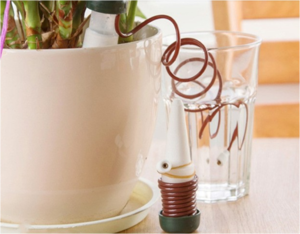
Externally this device looks like a spherical flask with a watering pipette, which is filled with water and inserted into the soil of a flower pot. When the earth begins to dry out, oxygen will begin to flow into the leg of the flask, thereby pushing out as much water as the plant needs. Balls for automatic watering are plastic and glass.
Bottle nozzle for automatic watering of indoor plants
The simplest and less costly solution is to buy a special bottle nozzle that sinks 2-3 cm into the soil and allows water to slowly flow into the plant pot.
Do-it-yourself automatic watering of indoor plants
It should be noted that it is possible to get out of this situation with a minimum of costs by making such devices yourself.
How to make automatic watering with your own hands?
To create a system automatic watering we will need ordinary droppers, which can be bought at any pharmacy, and a large container, for example, a five-liter water bottle. The number of droppers depends on the number of indoor plants, at the rate of one for each pot.
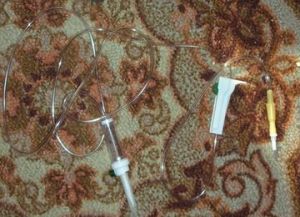
It should be noted that it is better to check this method of automatic watering in advance, since excessive moisture, as well as its complete absence, adversely affects even the most. Therefore, experiment in advance and, using the regulator on the dropper, determine the required water supply rate for each flower.
When flower growers need to leave home for a while, they are very worried that no one will look after their pets during their absence. Although if you have good friends or neighbors, then you can ask them to take care of the flowers while you are away. However, this is not the only solution in such a situation. Enough effective method plant care is the use of self-watering houseplants.
Ensuring the water regime for flowers
The easiest option to provide plants with moisture during your absence is place containers with flowers in a basin of water, and then you can be sure that for at least a week, and possibly two, your plants will be provided with enough water. This method is beneficial for the owner in that he does not have to spend additional funds. However, it is still better to use the automatic watering system for indoor plants, because it is able to maintain the optimal humidity of the flowers for a longer period.
How to prepare flowers for your absence?
Any grower, regardless of experience, knows that if you water the plants well, then they will have enough moisture for about two weeks. Therefore, if you have a planned departure, then it is necessary to carry out with regard to your pets certain preparations:

Organization of independent moisture supply
The main advantage of the automatic watering system for indoor plants is that they roots are regularly supplied with moisture in the required quantity. If you decide to make the homemade greenhouse described above, then you can increase the efficiency of its work by supplementing it with such a source of water, thanks to which your pets will receive life-giving moisture for several weeks.
The organization of a do-it-yourself automatic watering system for indoor plants has its own characteristics. At the same time, there is an easier-to-implement option. It will require ordinary plastic bottles, in which you must first make small holes in the lids. Next, the bottles are filled with settled water, turned upside down, and then placed between flower pots.
Throughout the day, moisture will flow to the bottoms of the pots in small drops, maintaining the humidity of the expanded clay layer where the flowerpots are located. However, it is necessary correctly calculate the diameter of the holes so that water enters required quantity. You can find out the optimal diameter experimentally. After that, you just have to decide how much bottle will be enough for your plants to constantly receive life-giving moisture.
When determining the size of the bottle, it is necessary to proceed from the size of the earthy clod in the pot. Let's say if you have fairly large pots in your room, then several large bottles of water are placed between them. If your mini garden consists of tiny pots, then this will be too much for them.
Industrial automatic watering devices
If you have sufficient financial resources, you can solve the problem of providing plants with moisture by installing an automatic automatic irrigation systems for industrial production.
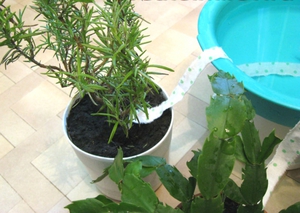
Other methods of water supply
Among other frequently used systems for automatic watering of indoor plants, one can distinguish a method in which flowers are connected to a container filled with water. through improvised wicks. Cords, ropes or woolen threads are suitable as the latter. It can also be ordinary bandages that need to be twisted, giving them the appearance of a cord.
When the wicks are ready, one end is immersed in a basin or other container of water, and the other is attached to the pot, fixing it in the substrate with a peg or clothespin. This design will provide a difference in capillary pressure, as a result, water will be directed through the wicks from the basin to the pot. The automatic watering system for indoor plants, based on the use of wicks, allows you to achieve a constant supply of moisture to plants at minimal cost.
Safety of Automatic Houseplant Watering
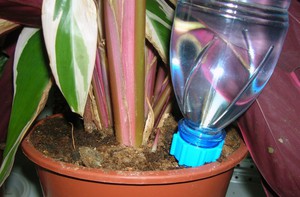 If it is important to you that your pets feel good while you are away, then for greater confidence, it will not hurt you check in work selected automatic irrigation system. So, it is advisable to make sure that moisture is supplied to the pots through a homemade wick well enough, and also whether you made a mistake with the supply of water in the basin.
If it is important to you that your pets feel good while you are away, then for greater confidence, it will not hurt you check in work selected automatic irrigation system. So, it is advisable to make sure that moisture is supplied to the pots through a homemade wick well enough, and also whether you made a mistake with the supply of water in the basin.
It is possible that after a day there will be no water left in the basin, and this is very dangerous for your flowers, which can dry out and die. Therefore, first of all, you need to choose bottles of suitable sizes so that your plants do not experience a lack of moisture during your absence. It is also necessary to correctly calculate the height of the placement of the basin with water so that moisture enters through the wicks in the required amount.
Capillary mats
You can also solve the problem of providing your pets with moisture with the help of capillary mats. They usually look like mats made of hygroscopic material. These products are presented in large quantities in specialized shopping centers, while they are distinguished by an affordable price.
Typically, capillary mats are laid on any available surface, for example, it can be a wide table or window sill. However, for effective use, one end must hang down into a container of water. Before laying the mat, be sure to lay an oilcloth, otherwise moisture drops can damage the table lining.
Sometimes the size of the mat does not allow immersing its end in a container of water. In this case, special strips can come to the rescue, which must be moistened in water, after which one end is placed under the mat, and the other is immersed in a container. The effect of using these strips will resemble homemade wicks that provide moisture. Also, to organize an automatic watering system at home, you can use special pallets, which are based on the principle of operation of capillary mats.
Their designs include:
- deep tray;
- small inner tray;
- capillary mat.
A large tray is used for water, a small tray is placed in it, which has a mat on the bottom. Next, a flowerpot with flowers is placed on it. Every day, through this rug, moisture will go to the flower pots. The advantage of this method of organizing the irrigation system is that it avoids the decay of plant roots.
Thus, today there are many automatic watering systems for indoor plants, each of which has its own characteristics. Therefore, if you are going away for a while and want to be sure that your plants will be provided with moisture, then you can choose any of the proposed systems that suits you best. Moreover, if you do not have sufficient funds to purchase an industrial production system, then if you wish, you you can make a simple system organization of automatic watering independently. Moreover, it will demonstrate the same level of functionality as the factory systems.
Conclusion
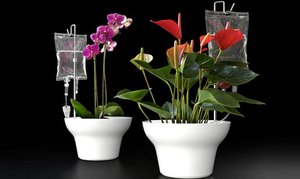 The owner, who is not indifferent to his indoor plants grown in the apartment, will try to do everything possible to create favorable conditions both during his presence and in those moments when he has to leave the house for a while. Such situations are not uncommon, so you need to have a plan, as in this case, to help the plants survive this period.
The owner, who is not indifferent to his indoor plants grown in the apartment, will try to do everything possible to create favorable conditions both during his presence and in those moments when he has to leave the house for a while. Such situations are not uncommon, so you need to have a plan, as in this case, to help the plants survive this period.
Each of us, repeatedly had to leave his home for a long time. We have dachas, friends in other cities, a desire to go abroad or to some resort sanatorium. Even a banal trip to nature with tents requires us to leave our entire household unattended. We can always take our beloved pets with us, but indoor plants ... Not each of us decides to transport all our home flora with us over long distances. Usually such trips take place in the summer, when moisture is especially needed for plants. Some flower lovers, upon returning home, are faced with an unpleasant phenomenon when their beautiful flowers turn out to be dried up after a long absence of the owner. The answer here is obvious - until now, you have not yet known a way to keep the soil of your houseplants in the proper soil moisture.
To begin with, you will need a container for water, the volume of the vessel should depend on the number of days of your absence and the individual characteristics of the water consumption of the particular plant being served. That is, if you are leaving for two or three days and your plant is a flower of medium whimsicalness in terms of moisture consumption, then a small bottle will be more than enough.
And, accordingly, if you are leaving for two weeks or more, and besides, your plant loves to drink very much, you will need a much larger bottle here. You need to accurately calculate the amount of liquid in exactly the same volume as if you were at home and watered the flower in your usual rhythm. Just in case, prepare water with a margin.
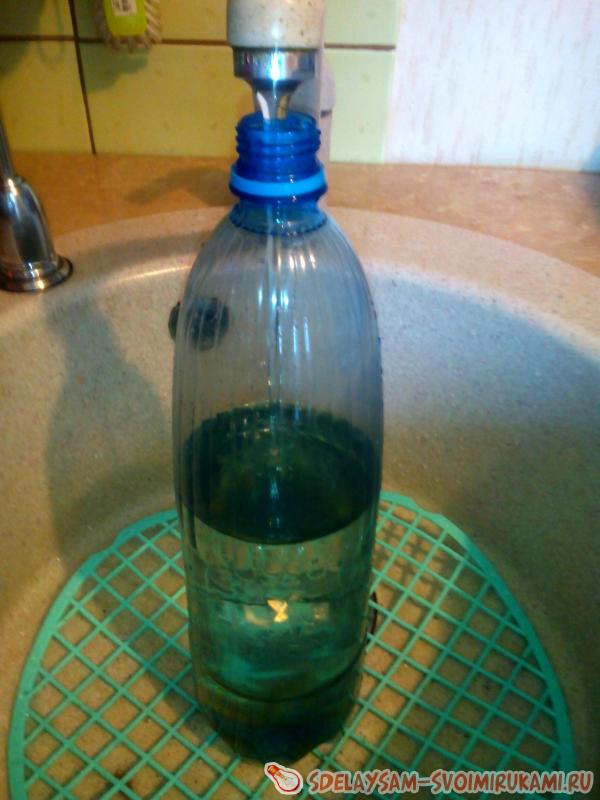
Now take an ordinary lace, it may be partly synthetic, but if it consists mainly of natural fibers, it will be good.
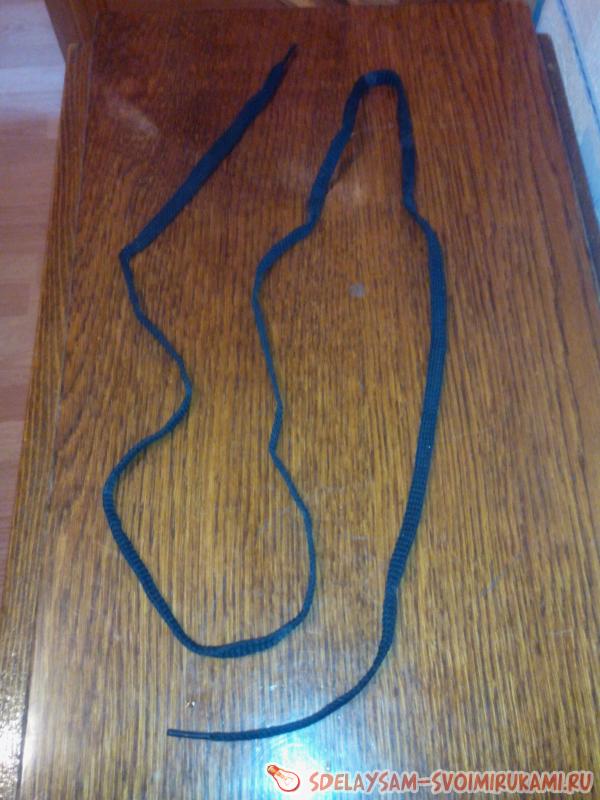
You can use fabric tape or soft rope for this purpose, here you can choose from what you have. Now you will need two weights.
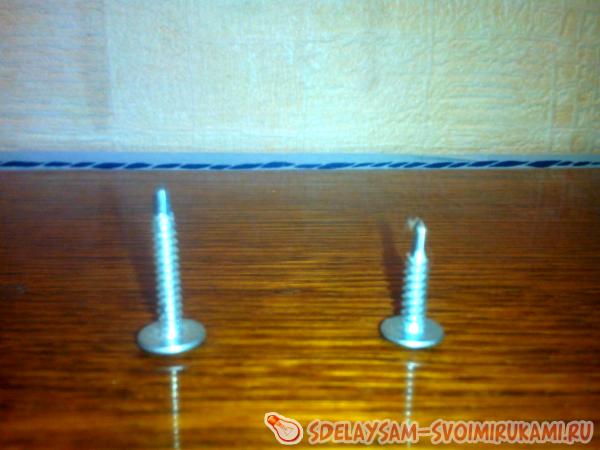
It can be anything: dowels, self-tapping screws, screws, bolts, nuts, the main thing is that they are not very large, but at the same time somewhat weighty. Next, fix the weights at both ends of the lace.
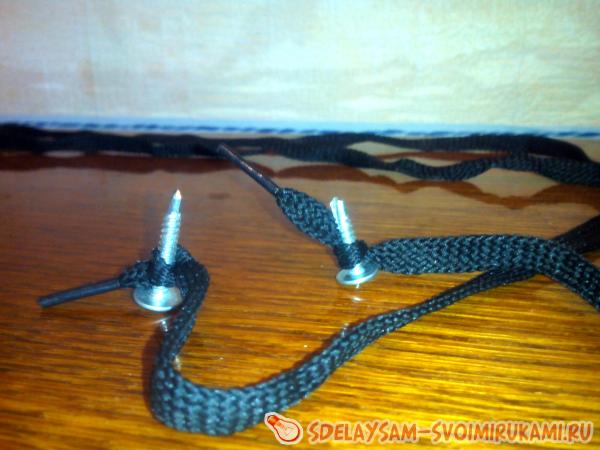
Wet one end well.
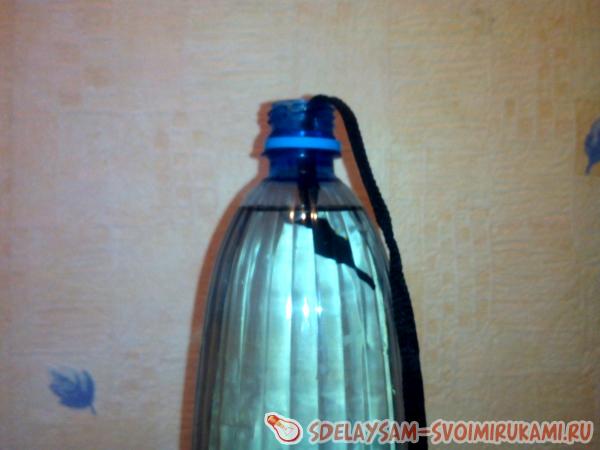
Take it out of the water and now soak the rest of the string in the bottle.
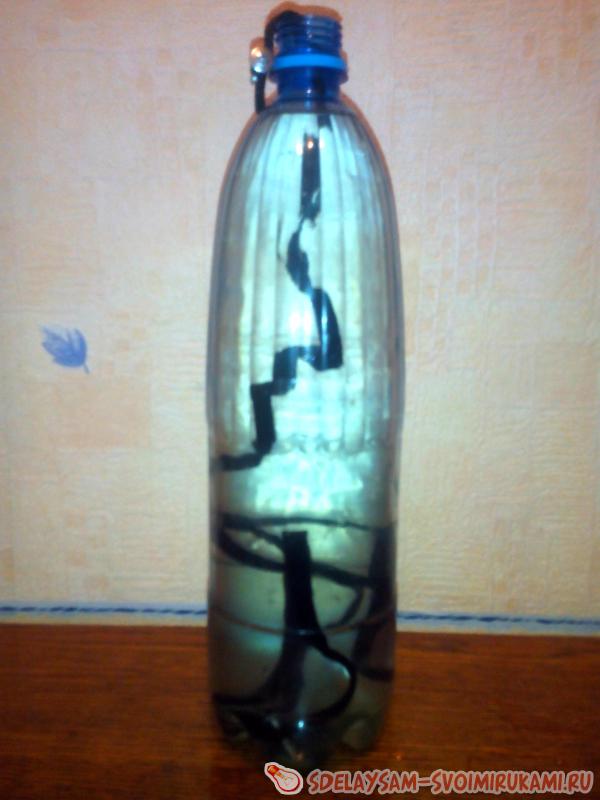
The entire lace should be perfectly soaked. Now on to your houseplant, place it on the floor.
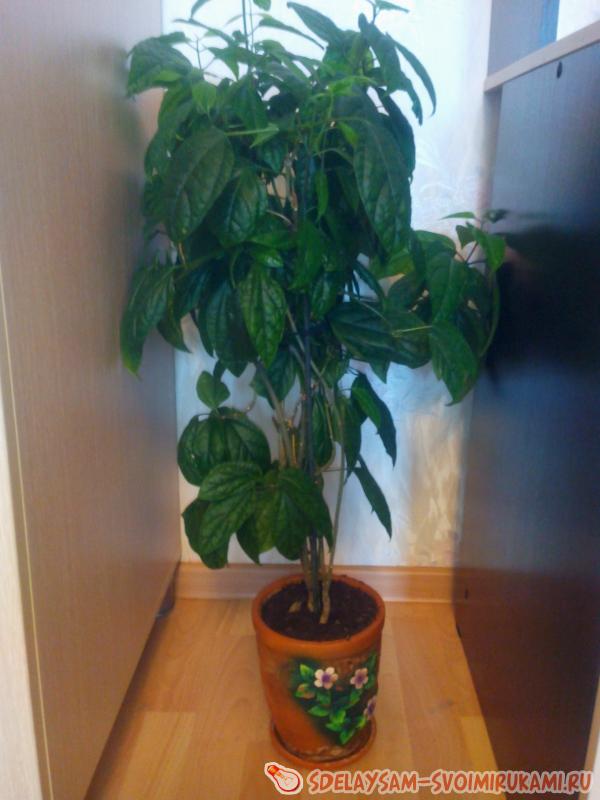
Place a vessel with water nearby, on an elevation - relative to the flower, for example, on a chair, as shown in the photo.
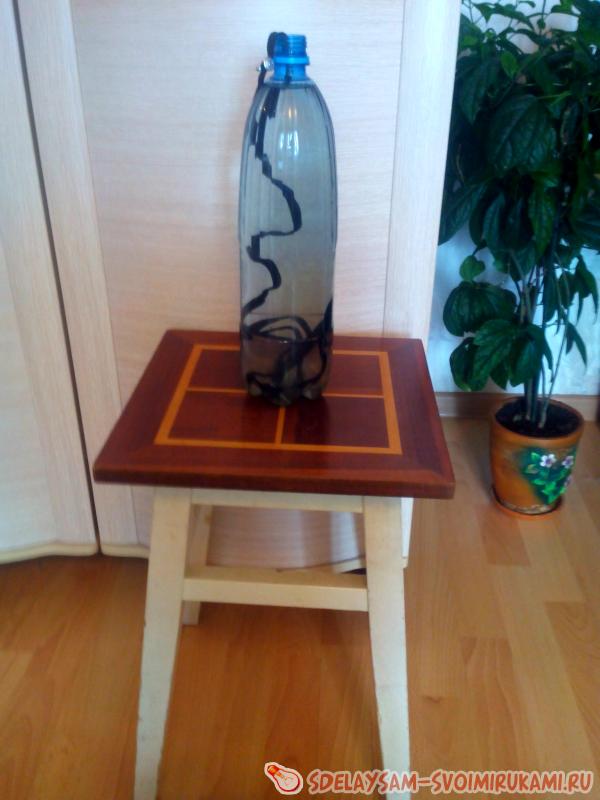
We will make a reservation right away that it is not at all necessary to put the flower on the floor, the main thing is that the vessel with water is at a level above the soil surface of the plant, the principle of communicating vessels works here. Water, like a stream, is looking for a lowland and finds it in a pot with a plant. This should be clear to you. Now we fix one end of the lace in the soil.
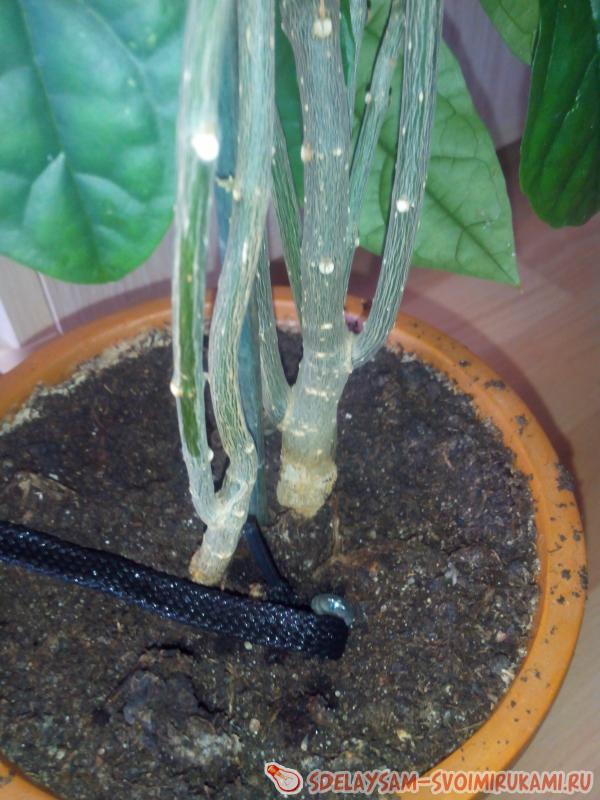
The other end of the string rests at the bottom of a vessel of water. The system is ready and functioning at 100%.
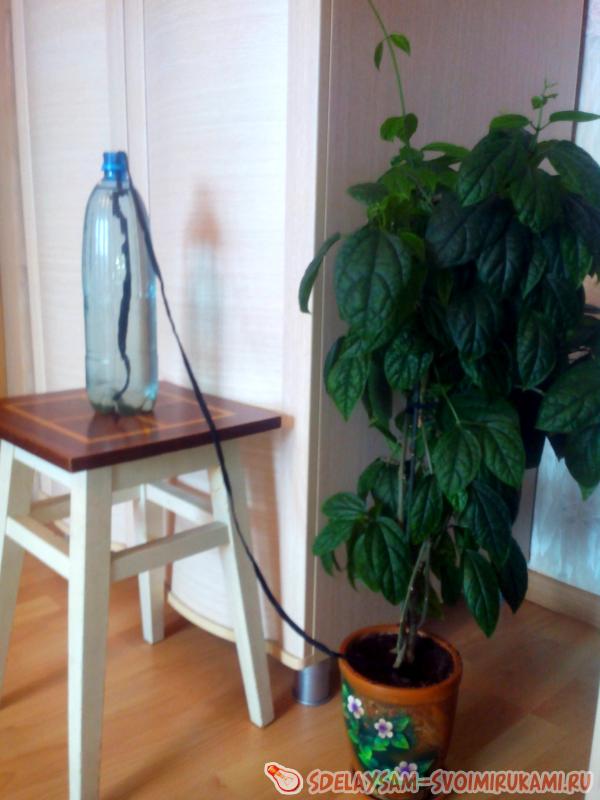
If you have a lot of indoor plants, and you are going to go on vacation for a while, the question arises: who will water them. Of course, you can ask neighbors or relatives to look after your "pets", but there is not always a person who can be without hesitation to entrust such a burden of responsibility.
In this case, do-it-yourself automatic watering options for indoor plants will come to the rescue.
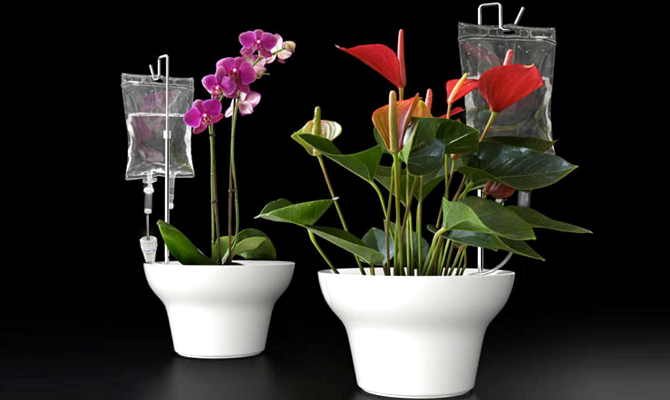
The simplest way to keep moisture
First, let's look at the stages of the simplest method of preserving moisture in flowers, which does not require large financial costs:
- It is necessary to water the plants abundantly, it is even better to place the roots with clods of earth in a bowl of water.
- From window sills and from other well-lit places in the apartment, it is better to move the pots to a darker room. This is done because less moisture evaporates in low light. But it should be noted that under such conditions, plant growth will slow down and some light-loving flowers may be oppressed.
- It is necessary to cut flowers and buds, rob dried leaves - in general, get rid of everything that is superfluous that consumes moisture.
- Then you should put all the pots in one container - a bath, a basin. Cover the bottom of the container with a layer of expanded clay about 5 centimeters and fill it with water. Between the pots, it is advisable to place pieces of wet sphagnum. The structure is covered with foil. The most capricious and delicate flowers can be placed in separate containers. However, attention should be paid to the fact that plants with pubescent leaves in such a greenhouse may begin to rot. Another disadvantage of this method is that after your return, the flowers will have to be gradually accustomed to the open air.
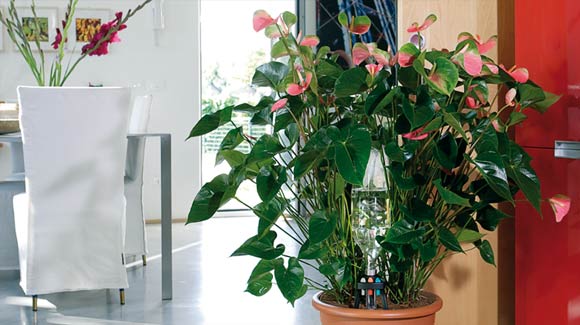
To improve this system for watering plants and make it more viable, additional sources of moisture should be provided. For this purpose, you can use plastic bottles, pour water into them, make holes in the lids and place them upside down between the pots. Thus, the water will gradually seep out, and replenish the soil layer with moisture. For small pots, a 0.5-liter bottle will suffice, for large tubs, one or more two-liter ones will be needed.
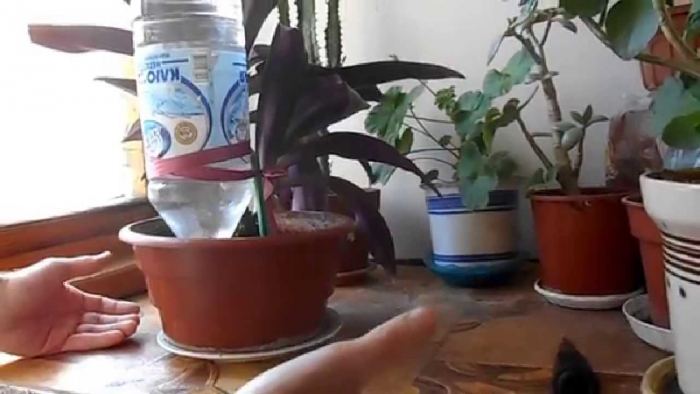
On sale there is a similar automatic watering for indoor plants of the production device. It consists of a flask connected to a container that is placed in the ground for uniform distribution moisture.
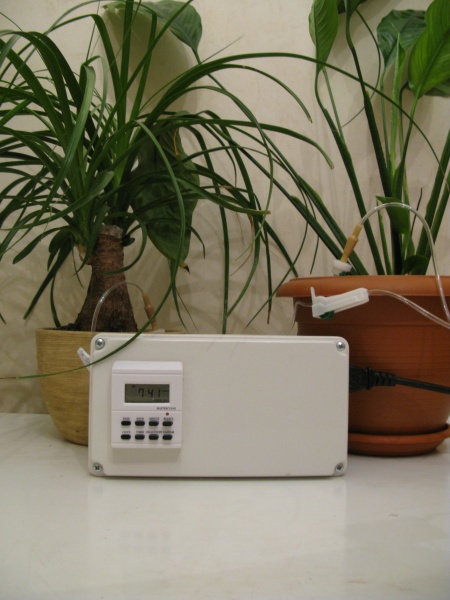
Wick
One of the most famous options for automatic watering plants is the Wick system. It is a container of water with many makeshift wicks, which are usually made from ropes or laces. One end of the rope is lowered into a container of water, and the other end into a pot with a plant.
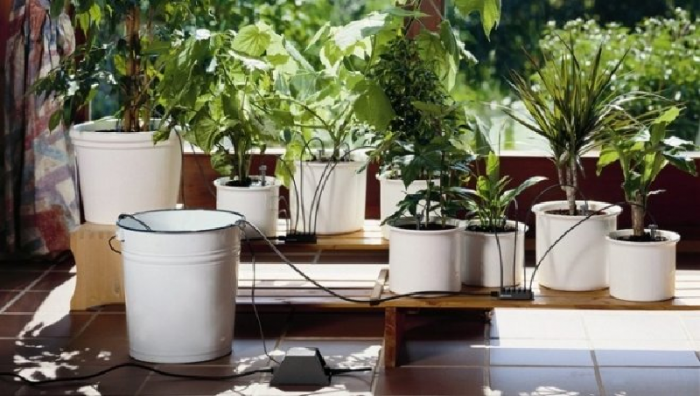
In order for the wick to hold firmly, it is fixed in the tub with a hairpin or peg. The most reliable option for attaching a string to a pot is to thread it through the hole in the bottom of the pot before planting. If you are often away from home, then you can equip such a system and connect flower tubs to it to ensure regular watering. Don't forget to fill up the water tank on time.
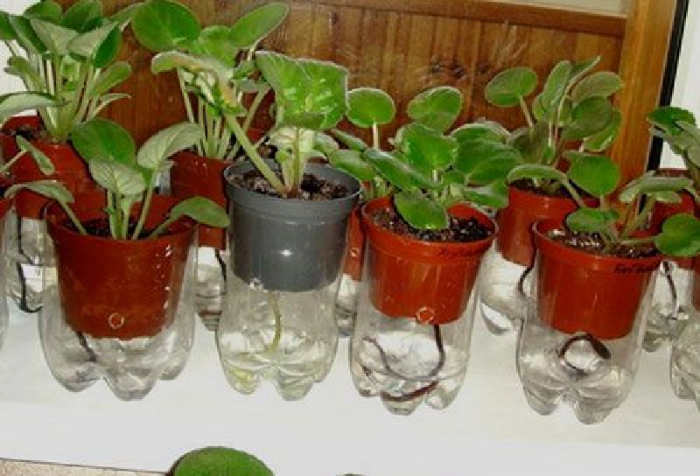
Wicks for this type of irrigation should be chosen from synthetic materials, as they better ensure the flow of water due to the difference in capillary pressure. The intensity of the moisture supply is regulated by the difference in height between the flower pots and the water tank: the higher the water is located, the more intense the watering.
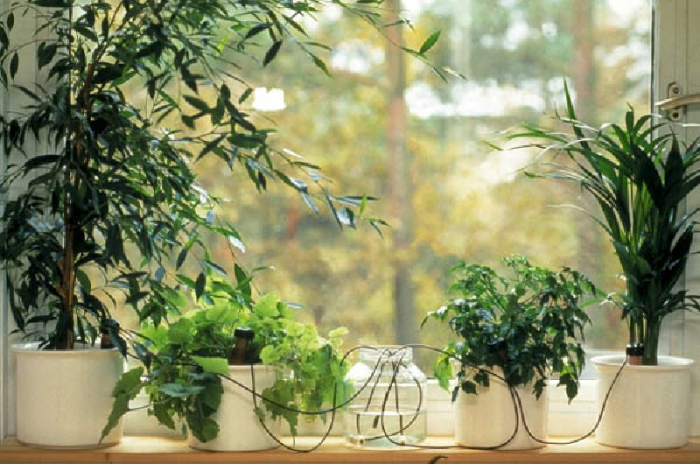
Automatic watering from droppers
Do-it-yourself automatic watering can be built from medical droppers, they need to be bought at a pharmacy in the amount of one dropper per one pot with a plant. Before installing the system, you should check each of them by blowing. Then fasten all the droppers without pinching the tubes, and weight the system with something so that the tips do not float in the water. Take a jar with a volume of 5-6 liters, pour water into it and place it above the level of the pots, place a structure of fastened tips in it, and place the other ends in tubs with plants. Open the water supply through the drippers and install slow drip irrigation.
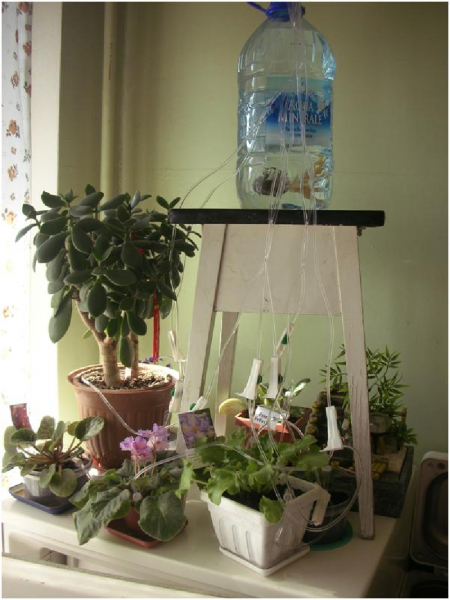
Automatic watering from a can of water
The simplest design of automatic watering can be constructed with your own hands from a pallet and a can. You will need a pallet with high sides (4-5 cm). A similar part from a refrigerator or a bath for photo printing may come up. A pot with a plant, which has holes at the bottom for seepage of water, is placed in a pan. Then they take a jar with a volume of 1-3 liters, depending on the size of the plant and the required time for automatic watering.
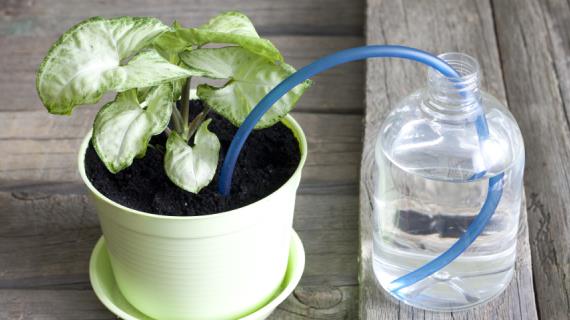
To ensure the correct level of water in the pan and pot, the cut of the neck of the inverted jar should be at the same level. Next, water is poured into the pan 1 cm higher than the required indicator. The jar is also filled with water and closed with a lid with a hole of such a size that it can be closed with a finger. Turn the jar upside down, holding the hole with your finger so that the water does not flow out of the jar. Then set the jar in the tray and remove the finger. As the plant consumes moisture, the water will gradually come out of the jar.
![]()
Advice! Any of the selected methods, made by hand or purchased, should be checked in advance. You need to make sure that the structural elements have sufficient water permeability so that the plant does not dry out.
If the intensity of moisture intake is weak, then it can be adjusted to the required level.
Ready-made automatic watering systems for indoor plants
From a technological point of view, automatic watering for flowers is a fairly simple design. It is a system of communicating vessels, one of which contains a supply of water, and a plant is planted in the other, it is provided by capillary irrigation directly through the soil. Such systems are also called planters with automatic watering. They may differ structurally, for example, a cone-shaped water tank is installed in a pot and connected above the pots with a tube with a water level indicator.
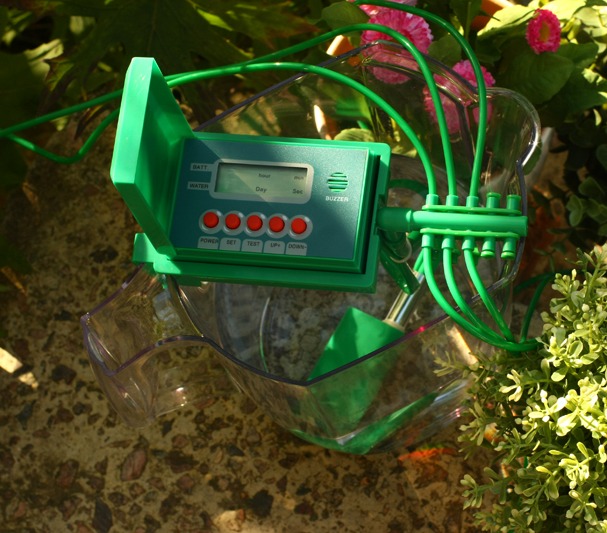
There is an option with a special dividing barrier, a tubular water level indicator and a reservoir through which the lower part of the plant pots is filled with water. Tube - the indicator is marked with divisions, by which you can find out if there is enough moisture in the pots.
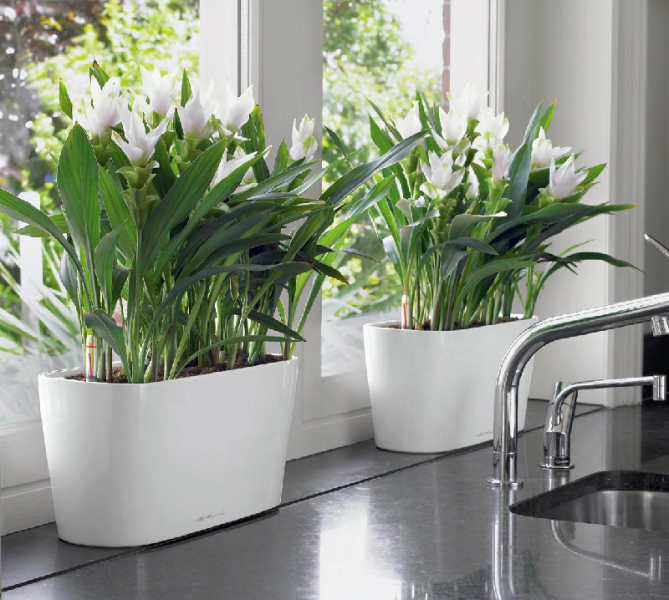
The disadvantages of such planters include the fact that they are only suitable for plants with a developed root system. Long roots will be able to reach the drainage layer and pull water out of the reservoir. If the plant has a small root or has only recently been transplanted, then its root system will not be able to feed on moisture from such a device. In this case, you need to wait until the root system develops, and only after that connect it to automatic watering.
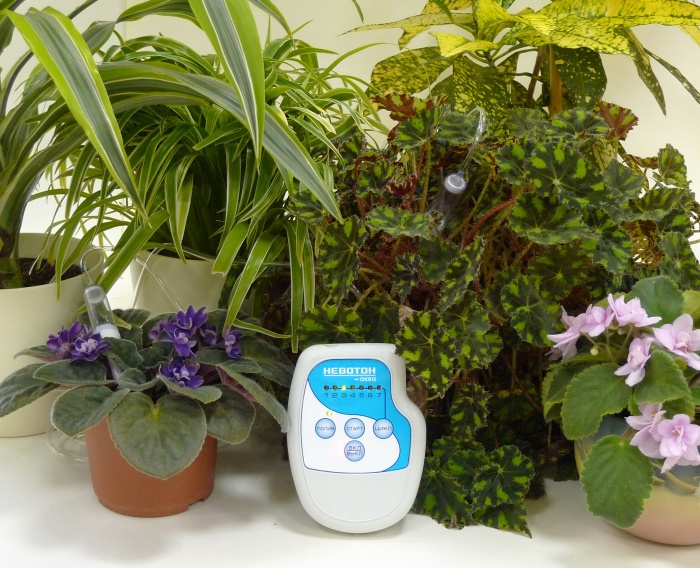
If you do not want to design a complex watering structure, then you can go to a specialized store and buy ready-made devices, for example, hydrogel, sprinklers, capillary mats.
Granular clay or hydrogel
In flower shops, you can buy granular clay or hydrogel. These materials absorb water very well and can retain it for a long time until they are given to the roots of plants.
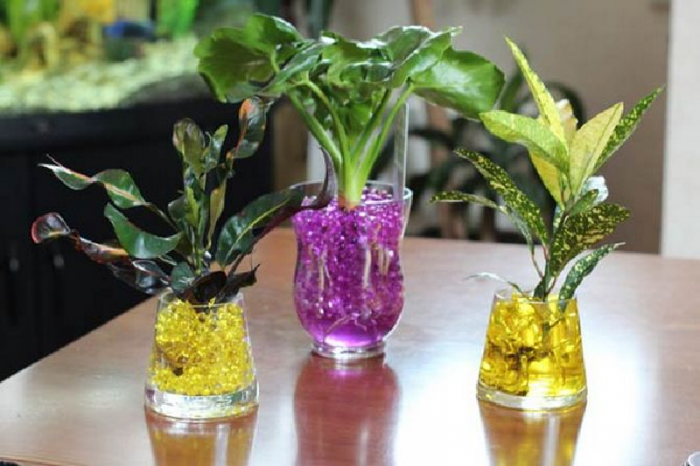
Granular clay is placed in a pot, after which a plant with an earthen lump on the roots is transplanted into it. Then a layer of granular clay or hydrogel is poured around the plant, the soil is covered with polyethylene. This material gives moisture to the roots of plants as needed, you just need to remember to add water to the pot if the hydrogel is dry.
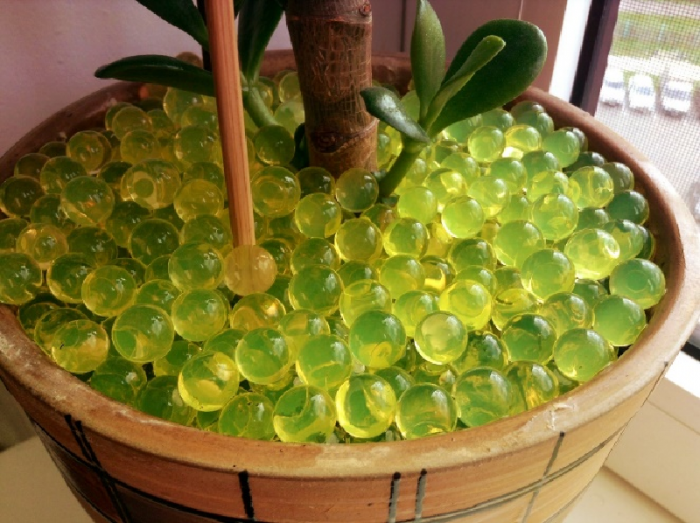
Sprinklers
bright and original way domestic manufacturers came up with the idea of irrigating the soil in a flower pot: colored plastic cones that are filled with water are stuck with a thin leg into the ground. When there is less moisture in the ground, oxygen enters the leg, it pushes out of the flask the amount of water that is needed for the roots. This method is well suited for home plants, garden plants, greenhouses, etc. It has a number of advantages: ease of use, no need to build a complex bulky structure, fits well into the interior.
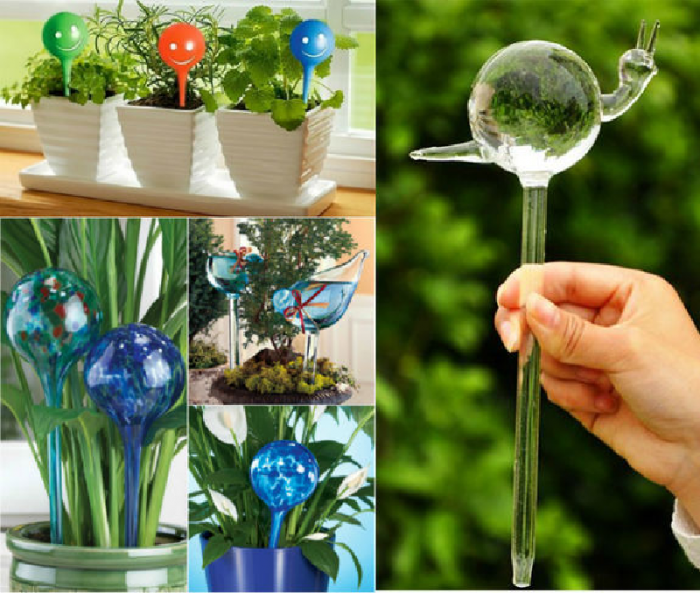
Capillary mats
In specialized stores, you can buy mats made from moisture-absorbing materials, they are called capillary mats. They are positioned so that one end is lowered into a container of water. After that, plant pots are placed on the mat. Pallets are sometimes included with capillary mats: water is poured into the outer pallet, the inner one is inserted into it and a rug is placed. Manufacturers of this automatic watering option promise that in this way the plant can be supplied with moisture for two weeks, and at the same time the roots will not rot.
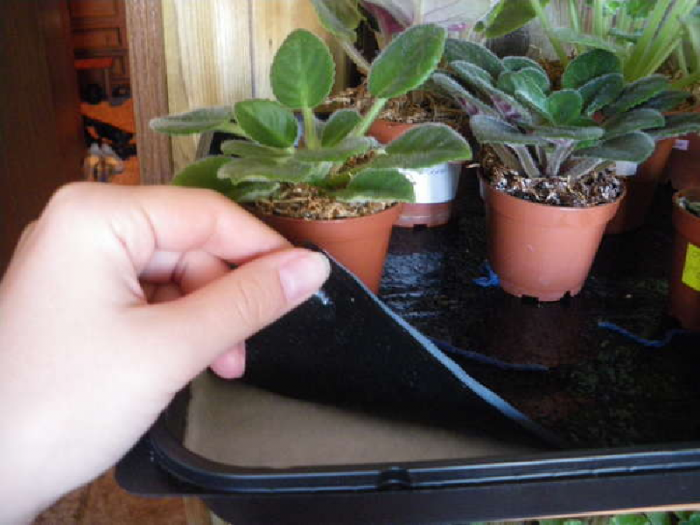
Experienced indoor plant lovers know that each variety has individual care features: ficuses and balsams love constant humidity, while cacti and orchids, on the contrary, have a negative attitude to excess water. Automated systems allow you to replenish the plant with moisture as it is spent, and flower growers only have to fill the tanks with water in time. Using automatic watering, plant lovers will make their lives easier, they will not need to constantly keep in mind information with a detailed watering schedule for each flower.
Conclusion
Having studied all the possible do-it-yourself and ready-made automatic watering systems, you will surely be able to choose the right way to provide life-giving moisture to your favorite plants.




















